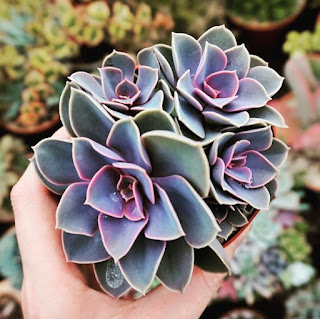How to care for Echeveria Violet Queen
Echeveria 'Violet Queen' – a true jewel in the crown of succulent enthusiasts! With her rosette shape, stunning silvery-lavender leaves, and a penchant for producing lovely pinkish flowers, she's a real head-turner. If you're lucky enough to have one of these beauties or are thinking of adding one to your plant family, you're in for a treat. Let's chat about how to keep your 'Violet Queen' reigning supreme in your indoor garden kingdom and how to propagate her so you can grow an entire royal court! If you would like to own an Echeveria Violet Queen you can buy one here.
Care for Your Echeveria 'Violet Queen'
1. Let There Be (the Right Amount of) Light!
Echeveria 'Violet Queen' thrives in bright, indirect sunlight. She loves soaking up the rays but can get a bit sunburnt if exposed to too much direct sunlight, especially during the scorching midday. A spot near a south or east-facing window where she can bask in the morning or late afternoon sun is ideal. If your 'Violet Queen' starts stretching out or losing her compact rosette form, it's a sign she's craving more light.
2. Water Fit for a Queen
Watering is a crucial part of Echeveria care, and 'Violet Queen' prefers a "soak and dry" approach. Wait until the soil is completely dry before giving her a thorough watering. Ensure the water drains freely, as sitting in wet soil could cause her royal roots to rot. During winter, she'll need less water as she takes a little rest.
3. The Throne: Soil and Pot
The perfect throne for your 'Violet Queen' is a well-draining cactus or succulent mix. Consider adding a bit of perlite or pumice to enhance drainage. A pot with drainage holes is a must – even a queen dislikes wet feet!
4. The Royal Temperature and Humidity
Echeveria 'Violet Queen' prefers mild to warm temperatures but can tolerate a chill down to about 30°F (-1°C). She's not a fan of frost, though, so bring her indoors if you live in a frost-prone area. As for humidity, she's not fussy – typical home humidity levels suit her just fine.
Propagating the Royal Lineage
1. Off with Their Heads! (Or Leaves)
Propagating Echeveria 'Violet Queen' can be done through leaf cuttings or beheading (sounds drastic, but it's for a good cause!). For leaf cuttings, gently twist off a healthy leaf from the stem, making sure it's a clean pull. Let the leaf callous over for a few days, then place it on top of moist succulent soil. For beheading, cut the top off the plant, leaving a few inches of stem. Let the cut end callous over, then plant it in soil. Both methods require patience, as it can take weeks to see roots and new growth.
2. The Birth of New Royals: Offsets
'Echeveria Violet Queen' may grace you with offsets, or "pups," growing around the base of the plant. Once these babies have grown a bit, you can gently separate them from the mother plant with a clean knife or scissors and pot them up in their own containers.
Extra Tips for Thriving Violet Queens
- Feeding: During the growing season (spring and autumn), you can feed your Echeveria Violet Queen with a diluted low-nitrogen succulent fertilizer to encourage growth.
- Pest Patrol: Keep an eye out for common succulent pests such as aphids and mealybugs. If you spot any, treat your plant with a gentle insecticide or remove pests manually with a cotton swab dipped in rubbing alcohol. There are lots of little places for bugs to hide on Echeveria Violet Queen so try to be extra vigilant, it is best to catch pests early before they get out of control.
- Grooming: Remove dead or dying leaves to keep your plant healthy and prevent any potential pest or disease issues. A pair of long tweezers can help to carefully remove dead leaves from any cracks.
Caring for Echeveria 'Violet Queen' is a rewarding endeavor that brightens any indoor garden with a touch of royalty. With these care and propagation tips, you'll be well on your way to nurturing a thriving collection of these succulent sovereigns. Long live the 'Violet Queen'!

.png)





